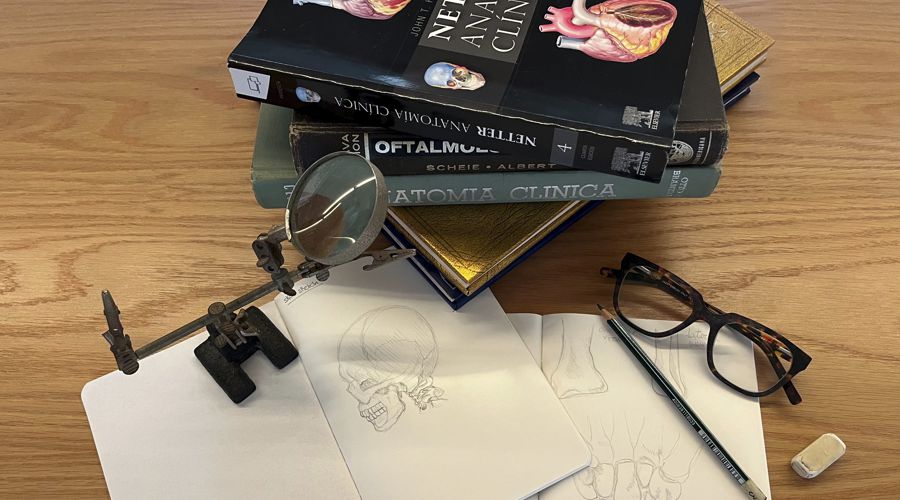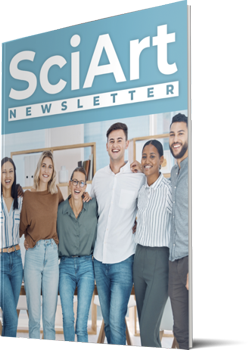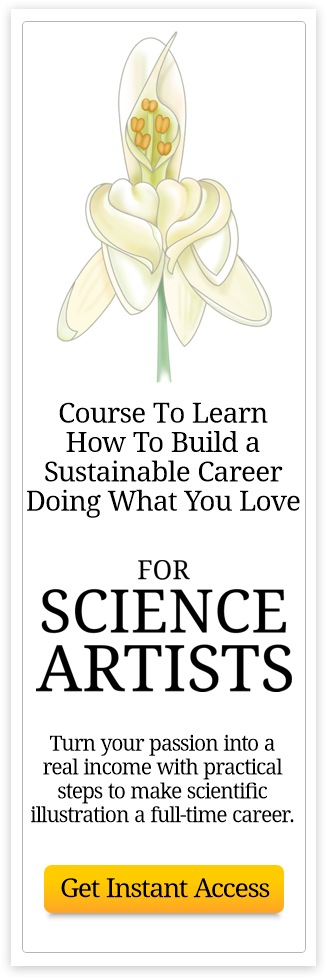
The Other Side of Scientific Illustration: Research as Creative Act
One of the things I love most about scientific illustration is the research.
There’s something deeply magical about diving into the unknown—especially when preparing to illustrate a scientific subject.
For me, this passion for learning began with my first human anatomy course. I remember feeling awestruck by the intricate design of the human body, from cellular structures to the complex dance of muscles and bones.
Since then, every new illustration has become an excuse to study, explore, and discover the “why” behind what I’m drawing.
If you’re anything like me, the thrill of learning can be just as rewarding as the act of illustrating itself.
Here’s something important I’ve learned along the way: thorough research isn’t about being perfect. It’s about something deeper and more meaningful:
It is about achieving ACCURACY.
It's about ensuring the meticulous and accurate depiction of scientific concepts and data in visual form.
Our illustrations are not just meant to be beautiful; they’re meant to be trustworthy. That trust is built on the quality of the information we use.
Still, I know that starting the research phase can sometimes feel overwhelming.
- Where do you look first?
- What sources are reliable?
- How much is “enough”?
These are common and completely valid questions, especially when facing a topic that’s new or outside your area of expertise.
In this article, I’ll walk you through the research process I use for every illustration project. From choosing sources to confirming accuracy, so that you feel more confident and supported the next time you sit down to bring science to life through your art.
Choose Reliable and Credible Sources
Once you’ve received a new illustration brief (or chosen a subject that inspires you) the first step is to begin gathering accurate information.
And that means learning how to choose your sources with care.
In scientific illustration, a reliable source is one that is backed by scientific evidence, peer review, or institutional authority. These sources provide information that is not only current but has also been verified by professionals working in the field.
There are generally two categories of sources to consider: paid and free.
💡📖 Paid Sources
Paid sources often include academic books, subscription-based journals, or databases that may require university or institutional access.
These are fantastic tools for building a strong foundation in your chosen field.
Over time, I’ve invested in key texts related to the branches of science I specialize in, and they’ve become trusted companions in my work. My favorite one is Medical Illustration.
If you're just starting out, know that you don’t need to buy everything at once. Specializing in one or two scientific areas makes it easier to build a meaningful (and manageable) personal library over time.
🌿 Free Sources
Sometimes, we find ourselves working on topics outside our specialty, or we simply don’t have access to all the paid materials we’d like.
That’s okay.
There are many excellent, trustworthy sources available for free. The key is to know where to look.
Here are some of the free, credible sources I regularly turn to:
Research Institutions and University Departments
Many universities publish accessible research summaries, articles, or visual material through their science departments.Museums and Scientific Collections
Museum websites often include detailed descriptions, images, and educational resources curated by experts.Government Organizations
National parks, health agencies, and conservation departments publish valuable and up-to-date scientific information. (For example: the U.S. Fish & Wildlife Service or NASA’s Earth Observatory.)Scientific Associations
Organizations like the American Ornithological Society, American Diabetes Association, or Botanical Society of America provide publicly accessible educational resources, position statements, and sometimes even downloadable illustrations or diagrams.Peer-Reviewed Open-Access Journals
Platforms like PLOS ONE or eLife offer high-quality articles that are freely accessible and grounded in research.Free Encyclopedias
While sources like Wikipedia can be useful for initial overviews or terminology, they should be cross-checked with more authoritative references. Use them as starting points—not endpoints.Figshare
This open-access platform is especially valuable. Figshare hosts research outputs shared by scientists—everything from datasets and figures to conference posters and diagrams.
It’s a great place to see how real scientists are visualizing their work and what terms or labels they use in their materials.
If you're a medical illustration artist, here you can find videos sharing new surgical advances from surgeons.
Build a Personal Library Over Time
As you grow in your career as a scientific illustrator, one of the most rewarding things you can do is begin building your own personal reference library.
It doesn’t have to be large or expensive. What matters is that it supports the kind of work you love to do.
Think of your library as a quiet companion to your creative process. With every new book, article, or resource you collect, you're deepening your understanding of the subjects you illustrate and strengthening the quality of your scientific illustration work.
If you’re not sure where to begin, consider starting with one or two scientific fields that truly inspire you.
Specializing allows you to dive deeper and become more confident with the terminology, structures, and visual conventions of that field.
Over time, you’ll find yourself able to work more efficiently and accurately, even on complex projects.
🏦💰Building a library doesn’t have to break the bank.
Here are a few gentle ways to gather quality references over time:
- Secondhand Bookstores and Online Marketplaces
Many classic science texts and illustration guides can be found gently used, often at a fraction of the original price. - University Libraries and Interlibrary Loan Services
If you have access to a university library, take advantage of it. Interlibrary loans can also give you access to books and journals far outside your immediate location. - Digital Resources and eBooks
Many academic publishers now offer eBook versions of scientific references—ideal if you prefer a searchable, portable format. - Publications from Museums and Scientific Associations
Museums often publish exhibition catalogs or field guides that double as beautiful and reliable reference material.
Even just a handful of trusted books can go a long way. You might find that certain references become like old friends—ones you return to again and again, not just for facts, but for confidence and inspiration.
In scientific illustration, your knowledge is part of your artistic toolkit. And slowly building a thoughtful, reliable library is a gentle way to invest in your future self—one book at a time.
Cross-Check and Confirm Your Sources
Once you’ve gathered your research, the next step is to make sure the information is accurate and consistent.
In scientific illustration, we’re often working with details that matter deeply. The placement of a vein, the coloration of a bird’s feather, the arrangement of flower parts… small inaccuracies can affect how the image is understood, especially by experts.
That’s why it’s essential to cross-check facts, figures, and visuals across multiple reliable sources before you begin illustrating. Even trustworthy sources can sometimes contradict each other, especially in fields where new discoveries are constantly being made.
📋Here are a few gentle tips for confirming your data:
Compare at least two or three different sources for the same piece of information. Do they describe the anatomy, behavior, or structure in the same way? Are the visuals consistent?
Look for recent publications when possible. Science evolves, and what was true ten years ago may have changed with new research.
Be cautious with images found online. If you’re using visual references, always try to trace them back to their original source especially if they come from unverified blogs, Pinterest, or AI-generated images. Reliable illustrations should come from peer-reviewed publications, museums, or scientific institutions.
Use context clues when something seems off. For example, if a plant structure looks exaggerated or labeled incorrectly, check against a botanical textbook or reputable herbarium resource.
As scientific illustrators, we’re visual translators of science. And like any good translator, we need to make sure we understand what’s being said before we attempt to communicate it visually.
Communicate with Your Client or Researcher
No matter how thorough your research is, some questions can only be answered by the person closest to the project: the scientist or researcher themselves.
Whether you're illustrating a newly discovered species or a complex cellular process, open and respectful communication is key to creating an illustration that is not only beautiful but also accurate and useful.
Many illustrators hesitate to reach out, worrying they’ll sound unprepared or bother the client.
But the truth is, thoughtful questions demonstrate your professionalism.
In the world of scientific illustration, showing that you care about precision builds trust, and often leads to stronger, long-term collaborations.
Here are a few gentle ways to open up a dialogue with your client:
✅ If something is unclear in the research material:
“I’ve reviewed the materials you sent and did some additional research. I noticed two slightly different descriptions of [X]. Before I begin sketching, I’d love to confirm which version is more accurate for your study.”
✅ When you’d like a visual reference:
“Would it be possible to share a photo, diagram, or paper that shows the structure of [Y]? I want to make sure I’m illustrating it in line with your findings.”
✅ When the project crosses into unfamiliar territory:
“This project touches on a topic I’m not as experienced with, so I’m doing extra background research. If you have any trusted sources or suggestions, I’d be happy to follow your lead.”
Clients and researchers are often grateful when you take the time to understand their work thoroughly. It shows that you’re not just creating an image, you’re helping communicate their science clearly and responsibly.
In the collaborative world of scientific illustration, good communication isn’t just helpful, it’s part of the craft.
Trust Your Growth as a Scientific Illustrator
If you’re just starting out, or even if you’ve been illustrating for a while, it’s completely normal to feel a little overwhelmed by the research process.
Scientific topics can be complex and constantly evolving, and it takes time to build the skills and confidence to navigate them with ease.
But here’s the good news: if you’re already approaching your work with curiosity, care, and a genuine desire to be accurate, you’re on the right path.
Research isn’t about knowing everything: it’s about learning how to ask the right questions, where to look for trustworthy answers, and how to interpret that information visually.
As you continue to grow in your scientific illustration practice, you’ll start to notice patterns, deepen your expertise, and develop your own system for researching effectively.
Trust that every project you take on (every book you read, every email you write to a client, every image you double-check) is helping you build a thoughtful, reliable foundation for your work.
And perhaps most importantly, try to embrace research not as a hurdle, but as part of your creative process.
When we allow ourselves to be fascinated, to dig deeper, to make connections, that’s where some of the most inspiring and meaningful illustrations are born.
So whether you're buried in journal articles or cross-referencing museum specimens, know this: your dedication to learning is part of what makes you a remarkable scientific illustrator.
Thanks for Reading 🖥️👓
I hope this article helped you feel more confident about the research side of scientific illustration. If you have a favorite source, strategy, or story about how research shaped one of your illustrations, I’d love to hear it. Feel free to share it by email at my personal email: alpha@thescientificillustrator.com or connect with me on social media.
And if you found this helpful, consider bookmarking the blog so you can return whenever you need a little guidance or subscribe to my newsletter:
LIKE THIS ARTICLE?
YOU'LL 🧡 THE NEWSLETTER!
Get timely tips to improve your services, land more projects, illustration tips, and more...

